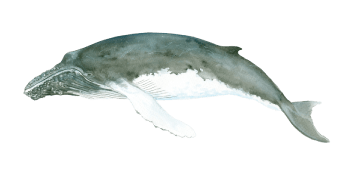
Humpback whale
(Megaptera novaeangliae)
Humpback Whales are one of the best studied of all large whales. Their long flippers, make the species easy to identify and have granted this species its scientific name, which means “big wing of New England”. Instead of teeth, they have baleen plates in their upper jaw which act as a filtering system (for further explications on baleen plates see Bryde’s Whale portrait).
Their head and lower jaw are covered with rounded tubercles (for sensory perception; similar to whiskers of cats). Humpback Whales often perform acrobatic jumps and are famous for their songs during mating periods.
When diving they often raise their flukes and their back has a humpy appearance, leading to the English name; Humpback.
The base color of their flukes its black with an individual pale color pattern that can be used in photoidentification.
General information
Further names: Portuguese: Baleia-de-bossa
Size of adults: Females up to 19 m; Males up to 17 m
Prey: Small schooling fish and krill
Behaviour: During feeding, some Humpback whale populations use a bubble-feeding technique, blowing “nets” or “clouds” of air bubbles to concentrate and trap prey (fish). Like most other rorquals, they are also lunge-feeders. They typically occur alone or in small, fluid groups of up to 12 animals. Very active at the surface, often seen breaching, lobtailing and flipper slapping. During the breeding season, adult males sing long and complex songs presumably to attract females. Such songs are population specific and change over time. During the winter Humbacks do not feed and rely on the fat reserves in their blubber for survival. They reach sexual maturity at around 5-11 years and can live to life span up to 50 years.
Range: Worldwide in all major oceans; large populations live in the Northern Atlantic and Pacific, as well as in the Indian Ocean. Individuals often cross between populations leading to distinct subspecies. They are highly migratory animals with each population following its own specific route but, in general, summers are used for feeding in polar regions and in winter they migrate to tropical regions to nurse or mate.
Madeira: Rarely sighted
Distinctive features: Variable dorsal fin ranging from high and falcate to relatively small. They have very long pectoral fins (flippers) that extend up to one-third of their body length and each Humpback has its own individual black-white pattern on the underside of its fluke.
Taxonomy: Suborder: Mysticeti (Baleen whales); Family: Balaenopteridae (Rorquals)
Threats: Habitat loss, environmental pollution (chemical and noise), entanglement in fishing gear, prey depletion, vessel collision.
